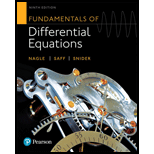
Concept explainers
Determine the intervals for which Theorem
a.
b.
(a)
The intervals for which Theorem
Answer to Problem 1RP
Solution:
Explanation of Solution
Given:
The given differential equation is
Approach:
Theorem
Suppose
So, here we will find the interval in which
Calculation:
Now
So,
Therefore
Conclusion:
Hence, the interval in which the theorem guarantees unique solution of the problem is
(b)
The intervals for which Theorem
Answer to Problem 1RP
Solution:
Explanation of Solution
Given:
The given differential equation is
Approach:
We will find the interval in which coefficient of given differential equation are continuous.
Calculation:
Simplifying the given differential equation
Here
So,
Therefore,
Conclusion:
Hence, the interval in which the theorem guarantees unique solution are
Want to see more full solutions like this?
Chapter 6 Solutions
Fundamentals Of Differential Equations And Boundary Value Problems Plus Mylab Math With Pearson Etext -- Title-specific Access Card Package (7th ... Fundamentals Of Differential Equations)
- Which degenerate conic is formed when a double cone is sliced through the apex by a plane parallel to the slant edge of the cone?arrow_forwardFor the problem below, what are the possible solutions for x? Select all that apply. 2 x²+8x +11 = 0 x2+8x+16 = (x+4)² = 5 1116arrow_forwardFor the problem below, what are the possible solutions for x? Select all that apply. x² + 12x - 62 = 0 x² + 12x + 36 = 62 + 36 (x+6)² = 98arrow_forward
- Select the polynomials below that can be solved using Completing the Square as written. 6m² +12m 8 = 0 Oh²-22x 7 x²+4x-10= 0 x² + 11x 11x 4 = 0arrow_forwardProve that the usual toplogy is firast countble or hot and second countble. ①let cofinte toplogy onx show that Sivast countble or hot and second firast. 3) let (x,d) be matricspace show that is first and second countble. 6 Show that Indiscret toplogy is firstand Second op countble or not.arrow_forwardH.W For any events A and B, show that 1. P(AB)s P(A)≤ P(AUB)≤ P(A) + P(B)arrow_forward
- a) Find the scalars p, q, r, s, k1, and k2. b) Is there a different linearly independent eigenvector associated to either k1 or k2? If yes,find it. If no, briefly explain.arrow_forwardPlz no chatgpt answer Plz Will upvotearrow_forward1/ Solve the following: 1 x + X + cos(3X) -75 -1 2 2 (5+1) e 5² + 5 + 1 3 L -1 1 5² (5²+1) 1 5(5-5)arrow_forward
 Elements Of Modern AlgebraAlgebraISBN:9781285463230Author:Gilbert, Linda, JimmiePublisher:Cengage Learning,
Elements Of Modern AlgebraAlgebraISBN:9781285463230Author:Gilbert, Linda, JimmiePublisher:Cengage Learning,
